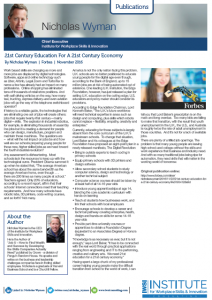By: Nicholas Wyman and Chase Norlin 02/06/2017.
Almost weekly, we hear of encroachments into big data systems in government, the military, finance, health, hospitality and retail – to name just some of the affected industry sectors. As awareness of our vulnerability has increased, demand for cybersecurity specialists has risen dramatically.
Cybersecurity is not a low-skill field. It requires general IT knowledge, specialist cybersecurity certifications, and, sometimes, knowledge about particular industry sectors such as finance and health. We need talented, skilled professionals to meet the demand. And we don’t need them in a few years – we need them now. How do we get enough people in the pipeline to meet the growing need?
One way is through apprenticeship. When you hear the word “apprenticeship,” you may conjure up an image of 17th century craftsmen huddled over wooden workbenches wielding chisels. But, in fact, today’s apprenticeship programs are becoming more sophisticated and progressive, and can be found in many modern fields including cybersecurity.

Dollar for dollar, no workforce training method packs as much punch as apprenticeship. Apprenticeships are key to addressing problems such as youth unemployment, widening income disparities and a shrinking middle class. Nine out of ten apprentices are employed immediately upon finishing their training, at an average starting salary of around $50,000 a year. In the cybersecurity field, the average starting salary is at least $70,000.
Apprenticeship in cybersecurity combines hands-on training with college coursework, and is paired with scalable wage increases. This earn-while-you-learn model leads directly to mastery without the burden of high tuition fees and student loan debt.
And, because the cybersecurity field relies so heavily on certification, apprenticeship is a natural fit. That’s not to say that people trained in cybersecurity need to stop at the certification level. Just the opposite, actually. Certification in the field is more valuable to employers than other IT fields and opens up a host of potential career pathways.
What apprenticeship does very effectively is get people qualified for specific, employer-defined jobs and trained in real-world settings more quickly than a traditional 4-year college path.
High-quality cybersecurity apprenticeship programs may have other benefits as well, such as fostering greater diversity and inclusivity in the IT workforce. Women and minorities are vastly under-represented in the IT field, and many leading IT firms want to change this.
Apprenticeships can target this untapped talent pool because it gives these under-represented groups an affordable, practical and flexible pathway to well-paid employment.
Apprenticeship can also target another potential skill source – incumbent workers who have general IT skills but not the specific set of skills needed for cybersecurity work. An in-house apprenticeship program can give current employees the extra training and qualifications they need to meet the growing cybersecurity demand, while lessening or eliminating the burden of recruitment.
There is already movement at the state and national level to fast-track cybersecurity apprenticeships. The state of California is working to create fully approved apprenticeship programs as well as intensive cybersecurity bootcamps. At the national level, the Department of Labor (DOL) has approved a new apprenticeship framework in cybersecurity that encompasses eight primary job functions and a wide array of job-related competencies and technical skills.
The federal framework also includes a number of career pathways people can pursue after they complete the apprenticeship, including security analyst, network security engineer, information systems security manager and information assurance security officer. Employers who adopt this framework can fast-track DOL approval for their cybersecurity apprenticeship program.
In short, apprenticeship is an excellent way to close the large and growing gap between demand and supply in this critical field, with spillover benefits that include increasing diversity in the IT field, expanding the skill set of existing workers, and minimizing student debt. It’s time to seek out and fast-track your local apprenticeship program to a more cyber-secure future.
Nicholas Wyman is CEO of the Institute for Workplace Skills and Innovation and author of, JOB U: How to Find Wealth and Success by Developing the Skills Companies Actually Need. He writes about job skills and training in the 21st-century workplace.
Chase Norlin is the CEO of Transmosis, an organization founded by Silicon Valley Technology Entrepreneurs dedicated to the research and application of technology to strengthen the American workforce.



 Any assessment is disheartening. Most schools lack the resources to keep up with the technological curve. President Obama summed it up when he stated that, “The average American school has about the same bandwidth as the average American home, even though . . . there are 200 times as many people at school.” Teachers agreed. Only 20% of educators, according to a recent report, affirm that their schools’ Internet connections meet their teaching requirements. And how many schools have robotic labs, 3D printers, code writing courses, and so forth? Not many.
Any assessment is disheartening. Most schools lack the resources to keep up with the technological curve. President Obama summed it up when he stated that, “The average American school has about the same bandwidth as the average American home, even though . . . there are 200 times as many people at school.” Teachers agreed. Only 20% of educators, according to a recent report, affirm that their schools’ Internet connections meet their teaching requirements. And how many schools have robotic labs, 3D printers, code writing courses, and so forth? Not many.




